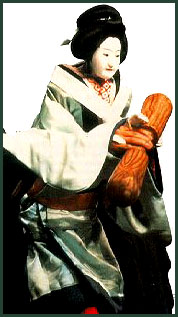|
|
|
japan Culture

A Glimpse of Japan
Asiatic Society of Japan
Bridge to J. History & Culture
Constitution of Japan
Famous Personages in Japan
Find Japan
Free Books on Japanese Culture
Gateway Japan
Japan-America Societies
Japan Foundation
Japan Ukiyo-e Museum
Japanappy Matchmaking
Japanese Gardens
Japanese Lunar Calendar
Japanese Museum Directory
Japanese Sword
Kinokuniya Bookstores
Korean Residents in Japan
Kyoto National Museum
Library of Congress Country Study
Library of Congress J. Doc. Ctr.
Museum Meiji-mura
Nippon Culture Mailing List
Old Photos of Japan
On-line Text Initiative (in Japanese)
Shiki Internet Haiku Salon
Stanford Guide to J. Info. Res.
Virtual Museum of Traditional Arts
World Haiku Review
-
Puppets:
Bunraku is nearly 1000 years old, but its rapid development as a popular
form of entertainment can be traced to the mid-17th century when several new
developments took place. First, there was a change from puppets operated by
a single, hidden puppeteer to a visible, three-puppeteer operation. Second,
the musicians were moved into a visible location and became part of the spectacle.
Finally, and probably most important, Chikamatsu, the "Shakespeare" of Japanese
theater, began to write for bunraku. He had achieved fame with his
kabuki plays, and when he became interested in bunraku it rapidly
increased the popularity of this art form.
The puppets have developed into remarkably life-like figures, roughly a meter
tall, with movable eyes, eye-brows, and jaws. The master puppeteer works the
head and the right hand, the second the left hand, and the apprentice the
legs. Together, they create an almost life-like effect. It's wonderful theater.
Noh is a classical Japanese performance form which combines elements of dance,
drama, music and poetry into one highly aesthetic stage art. Largely based
in the cities of Tokyo, Osaka, and Kyoto, it is performed throughout the country
by professional artists, mainly men, who have passed down the art among family
members for numerous generations. There is also a wide following of both male
and female amateurs who practice and perform its chant, dance, and instruments.
KYOGEN
Kyogen is the classical comic theater which balances the more serious Noh. While Noh is musical in nature, Kyogen emphasizes dialogue. The two are traditionally performed alternately on the same program and they share a common heritage. In addition to their own Kyogen repertoire of comic plays, Kyogen actors usually appear in interlude roles in Noh plays. Similarly, Noh instrumentalists also sometimes appear in Ky gen plays. The training methods of the two forms are also similar.
Noh developed into its present form during the 14th and 15th
centuries under the leadership of the distinguished performer -playwrights
Kannami and his son Zeami. Zeami, in particular, wrote numerous plays which
are still performed in today's classical reper-tory of some 250 plays. He
also wrote a number of secret works which explain the aesthetic principles
governing Noh and give details on how the art should be composed, acted, directed,
taught, and produced.
Noh flourished during Zeami's time under the patronage of the mili-tary shogun
Ashikaga Yoshimitsu. Later during the Edo period (1603-1868), Noh became the
official performance art of the military government. Feudal military lords
throughout the country supported their own troupes and many studied and performed
the art themselves.
With the societal reforms of the Meiji period (1868-1912), Noh lost its govern
mental patronage and was left to fend for itself. Although it nearly died
out, enough performers regrouped, found private spon-sors, and began teaching
the art to amateurs so that it slowly began to flourish again.
Today, like many classical performance forms throughout the world, Noh cannot
be described as a popular art among the Japanese people as a whole. Yet its
supporters are enthusiastic and its professional per-formers are highly trained
and extremely busy performing and teaching throughout the country. There are
today approximately 1,500 professional performers who make their living largely
through performing and teaching Noh.
-
There are five categories of Noh plays. In order, these feature gods, warriors, beautiful women, miscellaneous (notably mad-women or present-time) figures, and supernatural beings. During the Edo period, a full day's program consisted of the ritual piece Okina-Sanbaso followed by one play from each category in the above order. One Kyogen play would be presented between each Noh. Of the five categories, the women plays are the slowest in tempo but the most poetic, and of the highest level in expressing yugen, an aesthetic term suggesting quiet elegance and grace, and subtle and fleeting beauty.
-
The main character of a Noh play is called the shite (pronounced
sh'tay) who sometimes appears with one or more companion char-acters called
tsure. In many plays, the shite appears in the first half as an ordinary person,
departs, then appears in the second half in his true form as the ghost of
famous person of long ago. The former is called the maejite and the latter
the nochijite. They are traditionally performed by the same actor.
The secondary actor, the waki, is often a travelling priest whose questioning
of the main character is important in developing the story line. He also often
appears with companion waki-tsure. An interlude actor called ai or ai-kyogen
also often appears as a local person who gives further background to the waki,
and thus to the audience, in order to understand the situation of the shite.
-
A chorus called jiutai, usually consisting of eight persons, sits at the side of the stage and functions to narrate the background and the story itself. It also sometimes describes the character's thoughts and emotions or even sings lines for the characters.